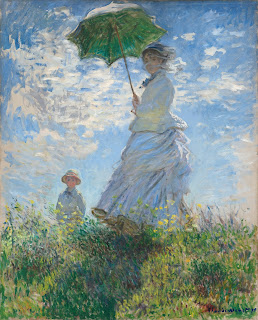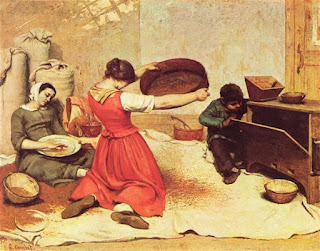Romantic Era
Impressionist art shows the evolution of the new art era through its colors. Yellows, blue and green were now the shades being used that along with quick brush strokes that changed the dynamics of art in the 1800s.
https://www.nga.gov/collection/art-object-page.61379.html#overview
Claude Monet’s Woman with a Parasol-1875 is an oil canvas that demonstrates his wife Camille and his son Jeon. Monet painted this in his home in Argenteuil while spending time in the garden. Monet is one of the first to create impressionist art and in this particular piece we can see how it painted in a way that a camera catches a picture, it gives an illusion that the painting is candid and as if his wife and son were caught off guard. The blue sky and clouds give off a bright light even though there is no sun in sight that takes you into the breezy and sunny day they may have been spending outdoors. Lastly, although their faces are painted in light strokes with a blurry and far away style, we can still get a glimpse at their expressions.
In this piece created by Berthe Morisot in 1874 called In a Park we can once again see the image being portrayed to be in the moment. Berthe chose to paint a mother and her children instead of the common pictures of woman in café’s that were popular during these times. Morisot is one of the first women to be demonstrated in an Impressionist exhibit and we can see the brushstrokes in the trees and field. Similar to Monet’s Woman with a Parasol, the faces of both the children and the woman aren’t clear and yet their emotions of love and serenity can still be seen.
https://www.wikiart.org/en/berthe-morisot/in-a-park
In comparison, Realist art demonstrated the ordinary life and subjects of livestock, middle class, farm workers in a day. It was meant to speak the truth of what is and disregard the images of the perfect world.
William Bouguereau painted The Shepherdess in 1889 that shows the woman barefoot and in a pose that is not meant to be elegant or forced but appears natural. In the background we can see animals, livestock that are also indicators to the type of art that is Realist. Bouguereau painted this woman in her natural setting that gives a glimpse to the viewers of what her life may consist of on a day-to-day basis. Lastly, the pigments of colors are dark switching from those pastel colors we once saw in Impressionist art.
https://www.williambouguereau.org/shepherdess/
Additionally, Gustave Corubet’s creation of The Wheat
Sifters in 1854 also shows us a peek into the ordinary life of a worker. Gustave
wanted others to learn about the way people in rural areas lived and he used
his art to demonstrate just what that life consisted of. His paintings were
commonly depicted and judged for having “ugly people” as his pieces
consistently showed servants and peasants that other’s were not fond of.
Impressionist art evoked emotions of peace and serenity from me. They remind me of times I spend at the park with my own family and the way the sun and wind feel on my skin. My favorite piece is Woman with a Parasol that I would love to own and show off. Meanwhile, Realist art is not something I would like to own but I do appreciate having. It is full of rich history that doesn’t tell stories of the rich, but tells stories of ordinary people. The Shepherdess also promotes emotions of peace from me, although her eyes are tired it also makes me feel envious of her way of life because of the simplicity in lifestyle that I wish to have. Both Impressionist and Realist art embark, different but candid truths that I appreciate.
References
B. (2013, April 28). Woman with a Parasol by Monet - Facts & History of the Painting. Totally History. https://totallyhistory.com/woman-with-a-parasol/
Impressionism - Important Paintings. (n.d.). The Art Story. https://www.theartstory.org/movement/impressionism/artworks/
The Shepherdess by William-Adolphe Bouguereau. (n.d.). William Bouguereau. https://www.williambouguereau.org/shepherdess/
The Wheat Sifters by Gustave Courbet. (n.d.). Gustave Courbet. http://www.gustavecourbet.net/the-wheat-sifters/
Woman with a Parasol - Madame Monet and Her Son. (n.d.). National Gallery of Art. https://www.nga.gov/collection/art-object-page.61379.html#overview







Comments
Post a Comment